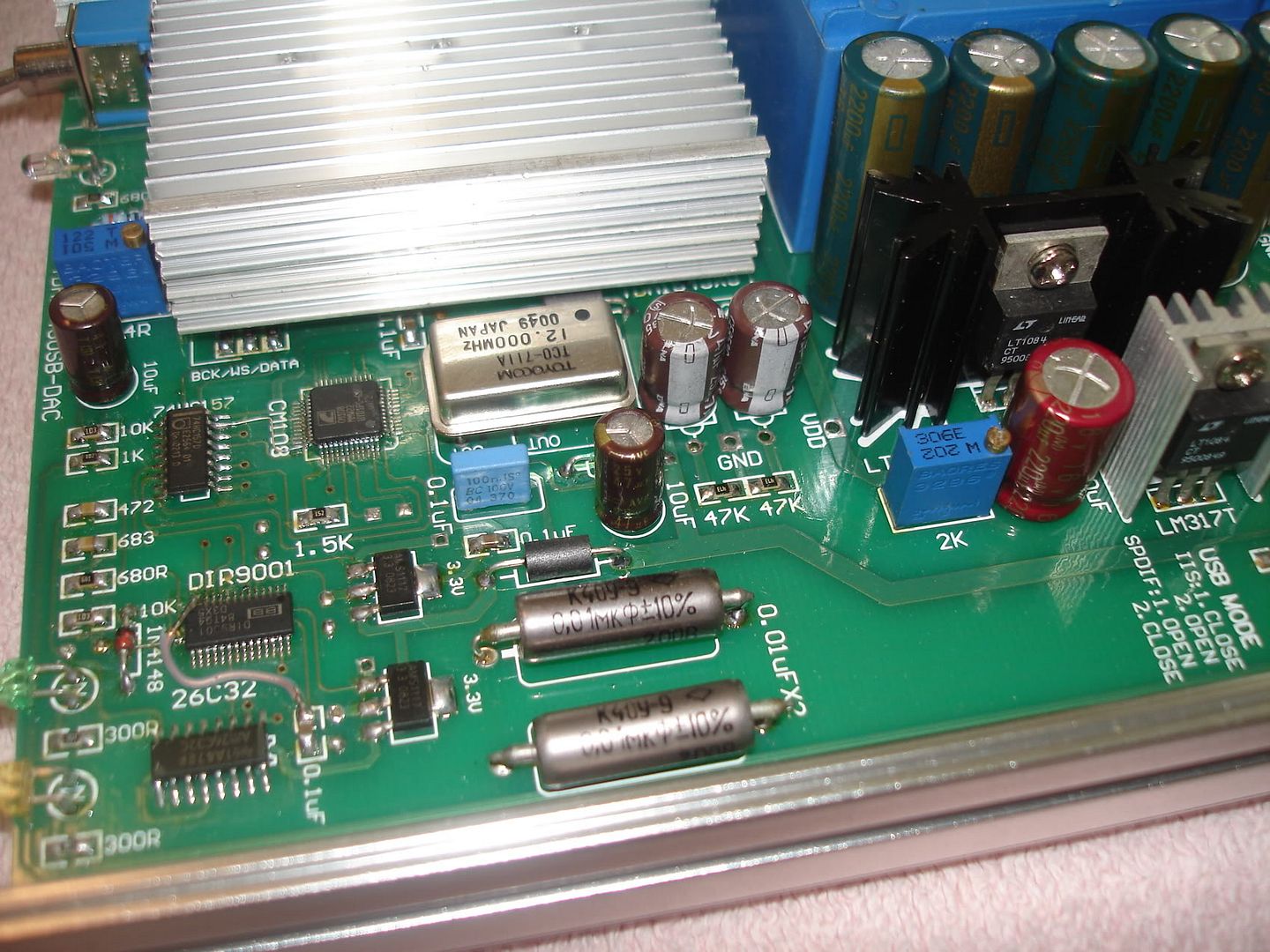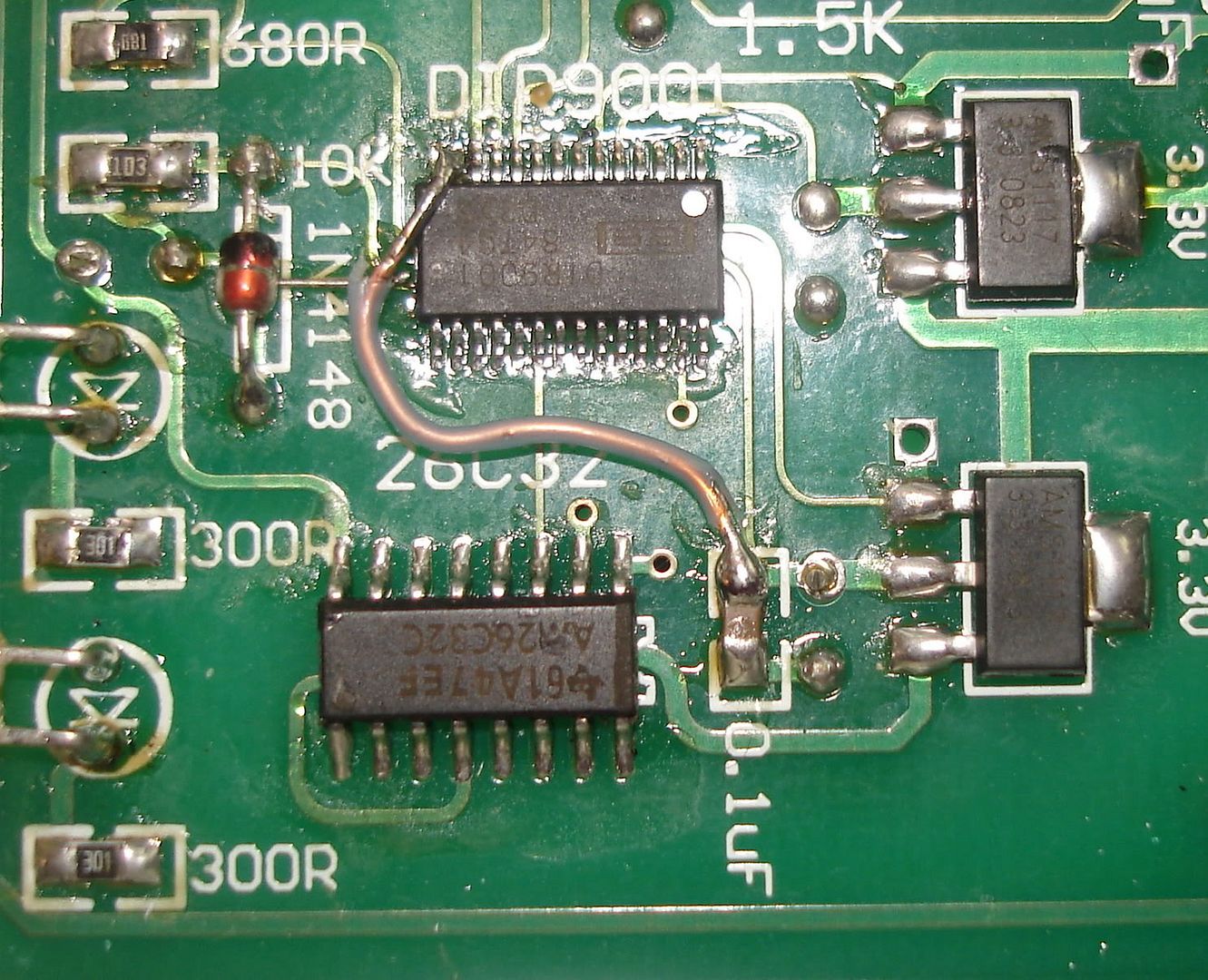Bill Allen
100+ Head-Fier
- Joined
- Jan 20, 2009
- Posts
- 238
- Likes
- 0
I caught Steve Nugent of Empirical Audio at a slow moment this week and we took a closer look at the DIR9001 data sheets.
http://focus.ti.com/lit/ds/symlink/dir9001.pdf
We discussed the feasibility of adding an external clock to the DIR9001 receiver chip for lowering jitter on the SPDIF inputs (Co-Ax/Toslink). His conclusion was there was no benefit in adding an XTI (external) 24.576 MHz Clock as discussed on page 16 of the data sheets. An external clock or the built in internal clock on the DIR9001 (PLL mode) is only used for recovering the clock from the SPDIF data stream (biphase input signal). While the DIR9001 receiver chip will lock onto any frequency from 28 kHz to 108 kHz, it can output only the same exact frequency as found at the input. 96/24 in 96/24 out. It will not up-sample, down convert or reclock the data. We audiophiles are mainly concerned with 44.1, 48, 88.2 and 96 kHz sampling and yes the Valab Dac can lock onto all these frequencies. It's just to bad 192 kHz is not an option for the DIR9001 as Steve Nugent just pointed out that the Phillips 1543 DAC chip "can" actually handle a 192 kHz input frequency, however it is limited to a 16 Bit word length. If you feed it a 24 Bit word it simply converts only the 16 most significant bits.
And here we all thought that the Valab's 1543 Dac chip was only capable of 44.1/16 ... Not so!
(This new found capability of the Valab Dac led me to an afternoon of playing native 96/24 music files and running software upsampling tests using my new Mac Mini. For now, suffice it to say the results were very interesting).
Steve and I then turned our attention to page 7 Figure 3, specifically the RECOVERED SYSTEM CLOCK (SCKO) JITTER vs. LOCKED SAMPLING FREQENCY graph. Notice how low the jitter is with a 512 fs. Doing a quick check per table 3 (page 14) we found pins 13 & 14 where grounded (L/L). This means the Valab Dac is set to 128 fs from the factory. Looking again at the jitter graph, we see 80ps at 44.1 kHz. With 512 fs jitter is cut in half to 40ps, that's substantial my friends!
Back to the solder bench. The legs on the DIR9001 chips are very small and required both reading glasses and my magnifying lens to perform this touchy operation. Be careful!!! Luckily pins 13 & 14 are located at the very end of the chip. What I did was cut each leg from the board with a razor blade. Then I carefully lifted the legs and soldered them together with a short piece of 28 gauge wire. This wire needs to go to positive 3.3 Volts, which provides the H/H as seen on Table 3, Page 14. Next I soldered this wire to the positive output from the small 3.3 volt surface mount regulator. Badda boom, badda Bing, the receiver chip is now set to 512 fs. (I will post a picture when I get a chance)
Normally this 512 fs would be output to the master clock input on a Dac Chip, however the 1543 Dac chip doesn’t even have a master clock input (SCKO). You see the 1543 is a "non" oversampling chip. Kapish? Steve Nugent claims that even modern Dac chips will not accept a 512 fs let alone a 384 fs master clock. However the 512 fs mod serves “our” purposes on the Valab Dac by lowering the SPDIF input clock jitter. AKA … The Poor Man’s Pace Car!
Well how does it sound???
In a word, Fantastic! I was able to compare "direct" SPDIF, USB & Pace-Car inputs at 44.1/16 Bit. While neither the USB nor the newly tuned SPDIF input could compare to the Pace Car input, the "direct" SPDIF input took a big step in the right direction. Having the Pace-Car on tap allows me to hear ultra low jitter, and yes, the 512 fs mod most definitely lowered jitter and improved the sound. Musically this comes off as more natural sounding 3D highs and a further increase in soundstage size. Nice!
Playing around will all manner of software upsampling on my new Mac Mini I ended up preferring 48 kHz 20 Bit with both SPDIF and USB input. I never tried this particular setting before, but to my ears it sounded the most like the Pace Car. Once again looking at Figure 3, you see jitter drop down to a very low 30 ps when playing 48 kHz signal. In the past I would have thought changing the fs and word length would have a negative effect on the sound but this clearly was not the case with my new Mac Mini. Humm! When I tried 96/24 the highs began to roll off, no doubt something to do with the 1543 Dac Chip 16 bit capability. Lowering to 96/20 and 96/16 progressively brought back the highs but 48/20 was still the madman in my system. That said the 512 fs mod will be well worth your time even if you are only using a 44.1/16 from a CD player.
Once again I would like to thank Steve Nugent for his continued support with the Valab Dac modifications. Steve is a true professional with excellent customer support and I can highly recommend all of his cutting edge digital audio products.
http://focus.ti.com/lit/ds/symlink/dir9001.pdf
We discussed the feasibility of adding an external clock to the DIR9001 receiver chip for lowering jitter on the SPDIF inputs (Co-Ax/Toslink). His conclusion was there was no benefit in adding an XTI (external) 24.576 MHz Clock as discussed on page 16 of the data sheets. An external clock or the built in internal clock on the DIR9001 (PLL mode) is only used for recovering the clock from the SPDIF data stream (biphase input signal). While the DIR9001 receiver chip will lock onto any frequency from 28 kHz to 108 kHz, it can output only the same exact frequency as found at the input. 96/24 in 96/24 out. It will not up-sample, down convert or reclock the data. We audiophiles are mainly concerned with 44.1, 48, 88.2 and 96 kHz sampling and yes the Valab Dac can lock onto all these frequencies. It's just to bad 192 kHz is not an option for the DIR9001 as Steve Nugent just pointed out that the Phillips 1543 DAC chip "can" actually handle a 192 kHz input frequency, however it is limited to a 16 Bit word length. If you feed it a 24 Bit word it simply converts only the 16 most significant bits.
And here we all thought that the Valab's 1543 Dac chip was only capable of 44.1/16 ... Not so!
(This new found capability of the Valab Dac led me to an afternoon of playing native 96/24 music files and running software upsampling tests using my new Mac Mini. For now, suffice it to say the results were very interesting).
Steve and I then turned our attention to page 7 Figure 3, specifically the RECOVERED SYSTEM CLOCK (SCKO) JITTER vs. LOCKED SAMPLING FREQENCY graph. Notice how low the jitter is with a 512 fs. Doing a quick check per table 3 (page 14) we found pins 13 & 14 where grounded (L/L). This means the Valab Dac is set to 128 fs from the factory. Looking again at the jitter graph, we see 80ps at 44.1 kHz. With 512 fs jitter is cut in half to 40ps, that's substantial my friends!
Back to the solder bench. The legs on the DIR9001 chips are very small and required both reading glasses and my magnifying lens to perform this touchy operation. Be careful!!! Luckily pins 13 & 14 are located at the very end of the chip. What I did was cut each leg from the board with a razor blade. Then I carefully lifted the legs and soldered them together with a short piece of 28 gauge wire. This wire needs to go to positive 3.3 Volts, which provides the H/H as seen on Table 3, Page 14. Next I soldered this wire to the positive output from the small 3.3 volt surface mount regulator. Badda boom, badda Bing, the receiver chip is now set to 512 fs. (I will post a picture when I get a chance)
Normally this 512 fs would be output to the master clock input on a Dac Chip, however the 1543 Dac chip doesn’t even have a master clock input (SCKO). You see the 1543 is a "non" oversampling chip. Kapish? Steve Nugent claims that even modern Dac chips will not accept a 512 fs let alone a 384 fs master clock. However the 512 fs mod serves “our” purposes on the Valab Dac by lowering the SPDIF input clock jitter. AKA … The Poor Man’s Pace Car!
Well how does it sound???
In a word, Fantastic! I was able to compare "direct" SPDIF, USB & Pace-Car inputs at 44.1/16 Bit. While neither the USB nor the newly tuned SPDIF input could compare to the Pace Car input, the "direct" SPDIF input took a big step in the right direction. Having the Pace-Car on tap allows me to hear ultra low jitter, and yes, the 512 fs mod most definitely lowered jitter and improved the sound. Musically this comes off as more natural sounding 3D highs and a further increase in soundstage size. Nice!
Playing around will all manner of software upsampling on my new Mac Mini I ended up preferring 48 kHz 20 Bit with both SPDIF and USB input. I never tried this particular setting before, but to my ears it sounded the most like the Pace Car. Once again looking at Figure 3, you see jitter drop down to a very low 30 ps when playing 48 kHz signal. In the past I would have thought changing the fs and word length would have a negative effect on the sound but this clearly was not the case with my new Mac Mini. Humm! When I tried 96/24 the highs began to roll off, no doubt something to do with the 1543 Dac Chip 16 bit capability. Lowering to 96/20 and 96/16 progressively brought back the highs but 48/20 was still the madman in my system. That said the 512 fs mod will be well worth your time even if you are only using a 44.1/16 from a CD player.
Once again I would like to thank Steve Nugent for his continued support with the Valab Dac modifications. Steve is a true professional with excellent customer support and I can highly recommend all of his cutting edge digital audio products.

























